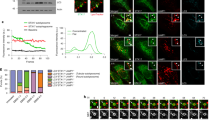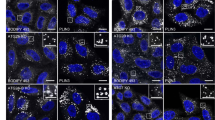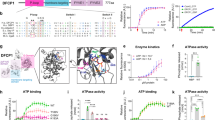Abstract
Autophagy is a lysosome-based degradation pathway. During autophagy, lysosomes fuse with autophagosomes to form autolysosomes. Following starvation-induced autophagy, nascent lysosomes are formed from autolysosomal membranes through an evolutionarily conserved cellular process, autophagic lysosome reformation (ALR), which is critical for maintaining lysosome homeostasis. Here we report that clathrin and phosphatidylinositol-4,5-bisphosphate (PtdIns(4,5)P2) regulate ALR. Combining a screen of candidates identified through proteomic analysis of purified ALR tubules, and large-scale RNAi knockdown, we unveiled a tightly regulated molecular pathway that controls lysosome homeostasis, in which clathrin and PtdIns(4,5)P2 are the central components. Our functional study demonstrates the central role of clathrin and its associated proteins in cargo sorting, phospholipid conversion, initiation of autolysosome tubulation, and proto-lysosome budding during ALR. Our data not only uncover a molecular pathway by which lysosome homeostasis is maintained through the ALR process, but also reveal unexpected functions of clathrin and PtdIns(4,5)P2 in lysosome homeostasis.
This is a preview of subscription content, access via your institution
Access options
Subscribe to this journal
Receive 12 print issues and online access
$209.00 per year
only $17.42 per issue
Buy this article
- Purchase on Springer Link
- Instant access to full article PDF
Prices may be subject to local taxes which are calculated during checkout








Similar content being viewed by others
References
Klionsky, D. J. Autophagy: from phenomenology to molecular understanding in less than a decade. Nat. Rev. Mol. Cell Biol. 8, 931–937 (2007).
Mizushima, N. Autophagy: process and function. Genes Dev. 21, 2861–2873 (2007).
Kraft, C. & Martens, S. Mechanisms and regulation of autophagosome formation. Curr. Opin. Cell Biol.http://dx.doi.org/10.1016/j.ceb.2012.05.001 (2012).
Klionsky, D. J. & Emr, S. D. Autophagy as a regulated pathway of cellular degradation. Science 290, 1717–1721 (2000).
Yu, L. et al. Termination of autophagy and reformation of lysosomes regulated by mTOR. Nature 465, 942–946 (2010).
Rong, Y. et al. Spinster is required for autophagic lysosome reformation and mTOR reactivation following starvation. Proc. Natl Acad. Sci. USA 108, 7826 (2011).
Zhang, H. et al. Genome-wide functional screening of miR-23b asa pleiotropic modulator suppressing cancer metastasis. Nat. Commun. 2, 554 (2011).
Pawlowski, N. Dynamin self-assembly and the vesicle scission mechanism: how dynamin oligomers cleave the membrane neck of clathrin-coated pits during endocytosis. Bioessays 32, 1033–1039 (2010).
Kirchhausen, T. Clathrin. Annu. Rev. Biochem. 69, 699–727 (2000).
Mettlen, M., Loerke, D., Yarar, D., Danuser, G. & Schmid, S. L. Cargo- and adaptor-specific mechanisms regulate clathrin-mediated endocytosis. J. Cell Biol. 188, 919–933 (2010).
Raiborg, C. et al. Hrs sorts ubiquitinated proteins into clathrin-coated microdomains of early endosomes. Nat. Cell Biol. 4, 394–398 (2002).
Popoff, V. et al. The retromer complex and clathrin define an early endosomal retrograde exit site. J. Cell Sci. 120, 2022–2031 (2007).
Shi, A. et al. Regulation of endosomal clathrin and retromer-mediated endosome to Golgi retrograde transport by the J-domain protein RME-8. EMBO J. 28, 3290–3302 (2009).
Di Paolo, G. & De Camilli, P. Phosphoinositides in cell regulation and membrane dynamics. Nature 443, 651–657 (2006).
Divecha, N. & Irvine, R. F. Phospholipid signaling. Cell 80, 269–278 (1995).
Funakoshi, Y., Hasegawa, H. & Kanaho, Y. Activation mechanisms of PIP5K isozymes by the small GTPase ARF6. Adv. Enzyme Regul. 50, 72–80 (2010).
van den Bout, I. & Divecha, N. PIP5K-driven PtdIns(4,5)P2 synthesis: regulation and cellular functions. J. Cell Sci. 122, 3837–3850 (2009).
Boronenkov, I. V. & Anderson, R. A. The sequence of phosphatidylinositol-4-phosphate 5-kinase defines a novel family of lipid kinases. J. Biol. Chem. 270, 2881–2884 (1995).
Rohde, G., Wenzel, D. & Haucke, V. A phosphatidylinositol (4,5)-bisphosphate binding site within mu2-adaptin regulates clathrin-mediated endocytosis. J. Cell Biol. 158, 209–214 (2002).
Levine, T. P. & Munro, S. Targeting of Golgi-specific pleckstrin homology domains involves both PtdIns 4-kinase-dependent and -independent components. Curr. Biol. 12, 695–704 (2002).
Lehto, M. & Olkkonen, V. M. The OSBP-related proteins: a novel protein family involved in vesicle transport, cellular lipid metabolism, and cell signalling. Biochim. Biophys. Acta 1631, 1–11 (2003).
Ford, M. G. J. et al. Simultaneous binding of PtdIns(4,5)P2 and clathrin by AP180 in the nucleation of clathrin lattices on membranes. Science 291, 1051–1055 (2001).
Smythe, E., Carter, L. L. & Schmid, S. L. Cytosol- and clathrin-dependent stimulation of endocytosis in vitro by purified adaptors. J. Cell Biol. 119, 1163–1171 (1992).
McNiven, M. A. & Thompson, H. M. Vesicle formation at the plasma membrane and trans-golgi network: the same but different. Science 313, 1591–1594 (2006).
Schmid, S. L. Clathrin-coated vesicle formation and protein sorting: an integrated process. Annu. Rev. Biochem. 66, 511–548 (1997).
Traub, L. M. et al. AP-2-containing clathrin coats assemble on mature lysosomes. J. Cell Biol. 135, 1801–1814 (1996).
Popoff, V. et al. Analysis of articulation between clathrin and retromer in retrograde sorting on early endosomes. Traffic 10, 1868–1880 (2009).
Ravikumar, B., Moreau, K., Jahreiss, L., Puri, C. & Rubinsztein, D. C. Plasma membrane contributes to the formation of pre-autophagosomal structures. Nat. Cell Biol. 12, 747–757 (2011).
Volpicelli-Daley, L. A. et al. Phosphatidylinositol-4-phosphate 5-kinases and phosphatidylinositol 4,5-bisphosphate synthesis in the brain. J. Biol. Chem. 285 (2010).
Acknowledgements
We are grateful to Olympus China, Nikon Instruments (Shanghai) and the Tsinghua Cell Biology Core Facility for providing technical support, and to Q. Dong, Y. Li and L. Huang for assistance with microscopy, TEM and image processing. We thank J-J. Liu for helpful discussions and J. Lippincott-Schwartz and J. Bonifacino (Cell Biology and Metabolism Branch, National Institute of Child Health and Human Development, Bethesda, USA) for constructs and antibodies. This research was supported by 973 Program grants 2010CB833704 and 2011CB910100, National Science Foundation grants 31030043 and 30971484, and Tsinghua University grants 2010THZ0 and 2009THZ03071 to L.Y., and NSFC grant 81030040, MOST grant 2008ZX09401—002, 2011CB809106 to J.X.
Author information
Authors and Affiliations
Contributions
L.Y. and Y.R. conceived and designed the experiments. J.X. designed SAMCell base screening and H.Z. manufactured the SAMCell chip. L.L. and S.C. carried out the mass spectrometric analysis. Y.R, M.L., Y.T. and Z.C. carried out screening. Y.R carried out the functional study with help from M.L. L.M, Y.T., H.R. and C.Z. performed the FEISEM in manuscript revision experiments. Y.L. carried out the embedding and ultrathin sectioning for TEM experiments. W.D. carried out the in vitro staining experiments. L.Y. and Y.R. wrote the manuscript.
Corresponding authors
Ethics declarations
Competing interests
The authors declare no competing financial interests.
Supplementary information
Supplementary Information
Supplementary Information (PDF 1061 kb)
Supplementary Table 1
Supplementary Information (XLSX 10 kb)
Supplementary Table 2
Supplementary Information (XLS 790 kb)
Supplementary Table 3
Supplementary Information (XLSX 27 kb)
Rights and permissions
About this article
Cite this article
Rong, Y., Liu, M., Ma, L. et al. Clathrin and phosphatidylinositol-4,5-bisphosphate regulate autophagic lysosome reformation. Nat Cell Biol 14, 924–934 (2012). https://doi.org/10.1038/ncb2557
Received:
Accepted:
Published:
Issue Date:
DOI: https://doi.org/10.1038/ncb2557
This article is cited by
-
The HEAT repeat protein HPO-27 is a lysosome fission factor
Nature (2024)
-
Multi-omic approach characterises the neuroprotective role of retromer in regulating lysosomal health
Nature Communications (2023)
-
LYST deficiency impairs autophagic lysosome reformation in neurons and alters lysosome number and size
Cellular and Molecular Life Sciences (2023)
-
Toll-interacting protein may affect doxorubicin resistance in hepatocellular carcinoma cell lines
Molecular Biology Reports (2023)
-
Recycling of autophagosomal components from autolysosomes by the recycler complex
Nature Cell Biology (2022)



